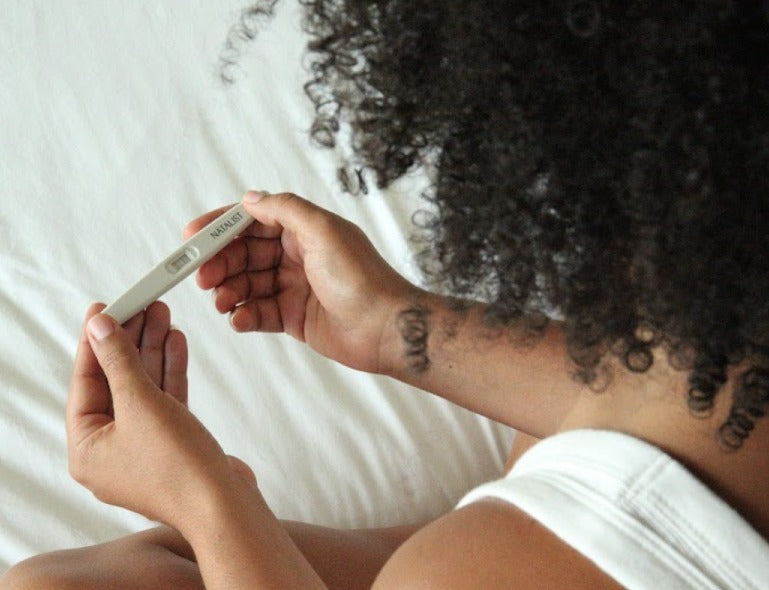Fibroids After Menopause: Symptoms, Causes, & Treatment

Originally published 07/11/2023. Updated for accuracy and relevancy on 06/06/2024
By Dr. Kenosha Gleaton, OBGYN
Fibroids are a commonly experienced condition in women and people assigned female at birth (AFAB), occurring in up to 80% of people.1 While fibroids are commonly experienced during peak childbearing years, it is possible for fibroids to be present during and after menopause. Here’s everything you need to know about the symptoms, causes, and treatment of fibroids after menopause.
What Are Fibroids?
Uterine fibroids, also known as leiomyomas, are growths or tumors made of fibrous tissue and smooth muscle.1 There are a few different types of fibroids, including intramural, subserosal, and submucosal fibroids. Fibroids are not cancerous and are often harmless, however, fibroids can cause some painful symptoms or interfere with fertility and pregnancy. Fibroids can range in size and location, sometimes found in between the walls of the uterus, or extending into the pelvic space or uterine cavity.1
The Connection Between Fibroids and Hormones
There isn’t one specific cause of fibroids, but many experts believe that hormones could play a role in fibroid formation. Certain hormones, such as estrogen and progesterone, can increase the risk of getting fibroids.2 These hormone levels are the highest during childbearing years and prior to menopause. Healthcare providers have observed that a decrease in these hormone levels is associated with the shrinking of uterine fibroids.1,2 A decrease in hormones may appear as a result of certain medications or the onset of menopause.
Fibroids and Menopause
Menopause is the point in time when a woman or person assigned female at birth has not had a period in 12 months. Menopause marks the end of the childbearing years when the ovaries begin to slow down hormone production. Menopause is often accompanied by hot flashes, irregular cycles, and other symptoms, and most often begins between the ages of 45 and 55.3 In a large number of cases, fibroids will begin to shrink in size after menopause due to a decrease in estrogen levels.1 Read more about fibroid degeneration →
Why Some Women Still Experience Fibroids After Menopause
So why do some people still have post-menopausal fibroids? There’s no easy answer, but it’s rare that fibroids will continue to develop or cause severe symptoms after hormone levels have dropped.2 That being said, one cohort study in California found that among 1,790 women, nearly a third of newly diagnosed uterine fibroids were found in people aged 45 to 49.1 Some research has shown that uterine fibroid cells express a certain type of enzyme that can actually make estrogen.1 This may explain why fibroids don’t consistently shrink after the ovaries stop producing estrogen. Genetics are also thought to play a role in fibroid formation.2
There are also other causes of abdominal pain, bleeding, and other symptoms often associated with fibroids. If someone is experiencing abdominal or pelvic pain or discomfort, they should speak to a healthcare provider to rule out other conditions.
Symptoms of Fibroids After Menopause
The symptoms of uterine fibroids after menopause are likely similar to those in premenopausal women and people AFAB. In a large majority of post-menopausal people with symptomatic fibroids, abnormal uterine bleeding is often the first or only symptom experienced.1 Other symptoms include2:
- Pain during sex
- Pain while urinating
- Pressure on the bladder or bowels
- Lower back pain
- Enlarged, bloating, or full feeling abdomen
Not everyone with fibroids will experience symptoms at all. Some fibroids can be as small as an apple seed, or as large as a grapefruit. The size, location, and quantity of fibroids will determine the severity of symptoms.4
Causes of Vaginal Bleeding After Menopause
Abnormal uterine bleeding is the cause of nearly 70% of gynecological consultations in perimenopausal and postmenopausal women and people AFAB.1 While uterine fibroids may be the cause of this bleeding, there are other conditions or causes to be aware of5:
- Thinning of the uterine or vaginal lining
- Side effects of hormone replacement therapy
- Uterine cancer or endometrial cancer
- Uterine polyps
- Cervical cancer
- Infection or inflammation of the cervix or uterus
This isn’t a comprehensive list but is indicative of the wide range of conditions that may result in symptoms such as abnormal bleeding. Be sure to speak to your healthcare provider about your symptoms and concerns so they can rule out more severe conditions.
Risk Factors for Fibroids After Menopause
As previously mentioned, we don’t know the exact cause of uterine fibroids. Researchers have pinpointed a few factors that can contribute to the likelihood of developing fibroids, such as hormone levels, genetics, and more.2 Some risk factors for fibroids include2:
- Vitamin D deficiency ( Shop Vitamin D Gummies!)
- Family history of fibroids
- Obesity
- Late menopause
- Early onset of menstruation
- Nulliparity (never having completed a pregnancy)
Treatment Options for Fibroids After Menopause
There are many different treatment options for fibroids before and after menopause. In many cases, treatment isn’t necessary if symptoms are not causing any complications.2 Additionally, if someone is nearing or recently menopausal, fibroids may shrink on their own and may not require any intervention.1 Let's take a look at some of the treatment options.
Hormone Therapies
Hormone therapy involves the use of hormones, hormone blockers, or hormone modulators.1 There are many different options available to manage fibroid symptoms or attempt to shrink fibroids with hormone therapy. While this can be useful for premenopausal people, the use of oral contraceptive therapy in older age isn’t always the best option. This is due to the increased risk of other conditions, such as stroke, heart disease, and others.1 Some other options, such as aromatase inhibitors and modulators can be used to suppress hormones such as estrogen. These methods have been useful in treating uterine bleeding in postmenopausal people.1
Surgical Treatments
Some surgical treatments are available for the treatment of fibroids. These include myomectomies or hysterectomies. A myomectomy is the surgical removal of a fibroid while leaving the uterus intact.1,2 A hysterectomy is the removal of the uterus which may or may not include the ovaries. When someone is postmenopausal, there is less of a concern with removing the uterus and ovaries as hormone production has likely already slowed or stopped and there is less of a need to preserve fertility.1,2
Non-Invasive and Minimally Invasive Procedures
Aside from the surgical removal of fibroids or the uterus, there are also non-invasive and minimally invasive procedures available for fibroid treatment. These include the use of ultrasounds, radio frequencies, heat, ice, and more.1,2 Treatments can include blocking the blood supply to the fibroids in order to shrink them in size or attempting to destroy the fibroids as well as the blood vessels.
Lifestyle Changes and Home Remedies
Treatment for uterine fibroids is not always necessary, especially if large fibroids begin to shrink after menopause. If symptoms are bothering you, you may benefit from taking over-the-counter- pain medications, using warm compresses, getting plenty of rest, and making some lifestyle changes.6 Some data suggest that a diet high in fruits, vegetables, and fiber-rich foods may help with inflammation and fibroid growth.7 For people wondering “Does vitamin D help with fibroids?” You’re in luck. Taking a multivitamin or supplements such as vitamin D may also improve the size and symptoms of fibroids.8 Your healthcare provider should be able to recommend other options for managing fibroid pain relief.
Key Takeaways
- Uterine fibroids are experienced in up to 80% of women and people assigned female at birth.
- Fibroids are most commonly experienced during childbearing years and typically shrink after menopause.
- Menopause results in a decrease in hormone production, including the hormone estrogen.
- There isn’t a definitive cause of fibroids before or after menopause, but certain genes and enzymes are thought to play a role.
- Symptoms of fibroids after menopause include abnormal vaginal bleeding, pain or pressure, lower back pain, and pain during sex.
- Treatment options for fibroids can vary from medications to surgical interventions to lifestyle changes and home remedies.
- A healthcare provider should always be consulted when experiencing any concerning symptoms to properly diagnose the cause and rule out underlying conditions.
Dr. Kenosha Gleaton is board-certified in gynecology and obstetrics and is the Medical Advisor of Natalist. She received her MD from MUSC and completed her residency at Carolinas Medical Center in Charlotte, NC.
Dr. Gleaton is passionate about women, youth, and mentoring. She is a Scrubs Camp instructor, a program to increase student entry in healthcare, and serves as a Compassion International adoptive parent. She is also a member of the American College of Obstetrics & Gynecology, the American Association of Gynecologic Laparoscopists, and the American Association of Professional Women.
References:
- Ulin M, Ali M, Chaudhry ZT, Al-Hendy A, Yang Q. Uterine fibroids in menopause and perimenopause. Menopause. 2020;27(2):238-242. doi:10.1097/GME.0000000000001438
- Florence AM, Fatehi M. Leiomyoma. [Updated 2023 Jan 4]. In: StatPearls [Internet]. Treasure Island (FL): StatPearls Publishing; 2023 Jan-. Available from: https://www.ncbi.nlm.nih.gov/books/NBK538273/
- What is Menopause? NIH. National Institute on Aging. September 30 2021. URL. Accessed June 21 2023.
- Eisinger, S. Uterine Fibroids. Office on Women’s Health. February 19 2021. URL. Accessed June 21 2023.
- Postmenopausal Bleeding. Cleveland Clinic. May 26 2021. URL. Accessed June 21 2023.
- Living with uterine fibroids. NIH. Medline Plus. January 10 2022. URL. Accessed June 21 2023.
- Tinelli A, Vinciguerra M, Malvasi A, Andjić M, Babović I, Sparić R. Uterine Fibroids and Diet. Int J Environ Res Public Health. 2021;18(3):1066. Published 2021 Jan 25. doi:10.3390/ijerph18031066
- Ciebiera M, Ali M, Zgliczyńska M, Skrzypczak M, Al-Hendy A. Vitamins and Uterine Fibroids: Current Data on Pathophysiology and Possible Clinical Relevance. Int J Mol Sci. 2020;21(15):5528. Published 2020 Aug 1. doi:10.3390/ijms21155528
Reach Out, We're Here
Have questions about your order or products? For the speediest answer, check out our FAQ section. Need something else? Come find us below.
Please keep in mind our regular business hours; Monday-Friday, 9am-5pm CT.
Customer Support
support@natalist.com
Press Inquiries
media@everlyhealth.com
Business & Partnerships
team@natalist.com
Affiliates + Influencers
team@natalist.com
Job Openings
Careers Page
























